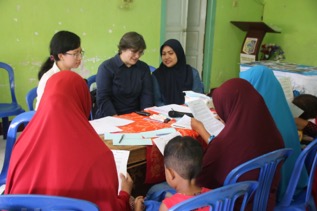
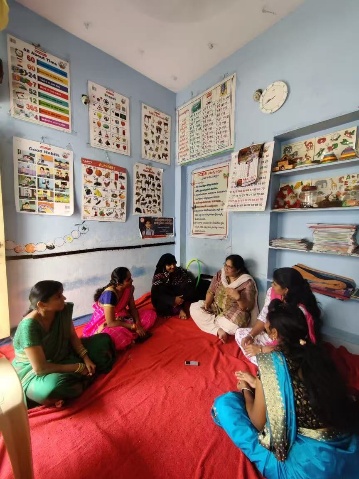
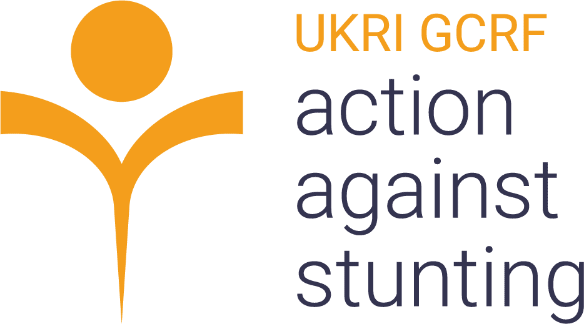
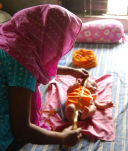
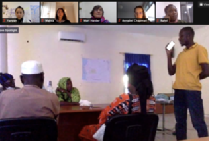
Keywords: shared values// cultural shared values // cultural determinants // stunting // project legacy // transdisciplinary research
Funded by: UKRI: GCRF joint funding but led by: MRC (Medical Research Council)
Key team members: MKH; AJC; HYY; CE; BCO
Funding period: Feb 2019 - Apr 2025
Key Contributions specifically to the WeValue Platform Knowledge
(This huge, £20m, 5-year project basically involved collecting several sets of multiple types of human samples, personal data and data on food environment, systems and networks, and cognitive performance from 500 families in each of Hyderabad, Kaffrine and East Lombok from early pregnancy to 24 months age of child. Health expertise in gut health, microbiomes, epigenetics, WASH, parasites etc. was involved, including local teams in each country and a UK lead team. The Shared Values workstream was only one part.)
In this project the WeValue InSitu approach was used to produce cultural portraits of the local people, and rich, thick descriptions of their daily lives, in order to provide contextual information to the Health Experts on two areas: a) cultural determinants that might be relevant to the occurrence of stunting in children, and b) cultural aspects which might influence the effectiveness of stunting health interventions. This project demonstrated that the WeValue InSitu approach could indeed deliver on these aspects (see Papers #29,34 below).
Transferability was also demonstrated well by this project: fieldwork took place with underprivileged communities in Hyderabad, East Lombok and Kaffrine, yet the WeValue InSitu approach proved itself effective in all these contexts (including with illiterate participants; requirements of different local languages and cultures).
The stages of preparation of bespoke local materials for new cultures as required in the WeValue InSitu process were also honed: completely bespoke Trigger Lists and localized sets of photos were co-produced with local researchers.
Training in WeValue InSitu was also developed hugely in this project: the team had to learn how to codify the otherwise design-led and more-intuitive, complex Facilitation processes. This permitted the team to explore the underlying theoretical concepts, and greatly assisted development of related high-quality papers #32, #25.
Relevant papers published: See papers #29, #33, #34, #36 in the Publication list. The subset below are noteworthy with respect to WeValue Insitu:
Moreno, J. M., Chapman, A. J., Ebido, C. C., Sougou, N. M., Diallo, A. H., Tening, R. N., Dial, F. B., Massonnie, J., Firoozmand, M., Niang, C. E. H. A., Heffernan, C. & Harder, M. K., 8 Jun 2023, In: Public Health Nutrition. 26, 11, p. 2418-2432 15 p.
DOI: https://doi.org/10.1017/S1368980023001088
A study of the use of WeValue InSItu in a health program, where it provided cultural information for contextual understanding of determinants of child stunting.
#34. Creating culturally-informed protocols for a stunting intervention using a situated values-based approach (WeValue InSitu): a double case study in Indonesia and Senegal
Chapman, A. J., Ebido, C. C., Tening, R. N., Huang, Y., Sougou, N. M., Kolopaking, R., Diallo, A. H., Anggorowati, R., Dial, F. B., Massonnié, J., Firoozmand, M., Niang, C. E. H. A. & Harder, M. K., 9 Apr 2024, In: BMC Public Health. 24, 1, 987 (2024).
DOI: https://doi.org/10.1186/s12889-024-18485-y
This demonstrates how WeValue InSitu Frameworks can provide cultural determinant information to inform intervention design.
Odii, B. C., Harder, M. K., Huang, Y., Chapman, A., Sougou, N. M., Kolopaking, R., Gavaravarapu, S., Diallo, A. H., Anggorowati, R., Fernandez Rao, S. & Heffernan, C., 27 Feb 2024, In: BMJ Paediatrics Open. 8, Suppl_1, 6 p., e001906.
DOI: https://doi.org/10.1136/bmjpo-2023-001906
A very limited and truncated overview of the protocol used with WeValue InSItu in a health program, but fuller details of an application where it provided cultural information for contextual understanding of determinants of child stunting.
Formal Project websites
GtR [https://gtr.ukri.org/projects?ref=MR%2FS01313X%2F1 ]
This is the UKRI site, including much detail (c25 pages) about the purpose, results, impact, partners.
Formal Project purpose:
More detailed information is provided below, taken from formal material about the overall project:
We urgently need to understand the 'cascade' of factors driving child stunting and the synergies and inter-relationship between drivers. And equally importantly, we need to better understand the 'tipping points' or the critical points along this cascade where healthy linear growth diverges to slow or no growth. To do this, we propose to transform our exploration of child under-nutrition from the component parts to the 'whole child'. Where the biological, social, environmental and behavioural context in which stunting occurs is understood in its entirety and where the strength and directionality of these drivers, inform related interventions. Based on this joined-up approach, we will explore the ability of a range of child-centred interventions to disrupt the cascade of factors that inhibit the ability of a child to grow. These actions and outcomes will then form the basis of a decision-making platform to enable users to identify the ex-ante and ex-post impacts of potential interventions. Embedded in this process, however, is a values-based approach that ensures that from the outset, our research directly connects to and betters the lives of the children, families and communities involved.
We will work across three countries: India, Indonesia and Senegal in over 50 communities. We aim to decrease child stunting by up to 10% our communities. Finally, to enhance our impact and legacy our Hub, we will engage a range of end-users in both our outputs and in the wider 'whole child' approach. We will support new regional platforms on maternal and child nutrition proposed by UNICEF linking the work of FAO/The World Bank/WHO at the country-level. We will also engage our network of over 100 civil society organizations in our findings. Over the course of the project, we expect to positively impact the lives of up to 1 million children.
Formal Project findings and impact
This was an incredibly complex, multi-layered project whose findings and impacts could be understood on several levels. The synthesis of the results from 12 health science disciplines plus shared values will take a further 2-3 years (due to delays from COVID and UKRI funding cuts). The challenges of collecting such a large amount of human sample data and then processing it has taken more time than expected. Therefore the results will be developed slowly over the next years after the end of the project in February 2025.
Formal documents and publications
See very detailed c25 pages of material at:
GtR [https://gtr.ukri.org/projects?ref=MR%2FS01313X%2F1 ]
Further information (taken from the overall project materials)
The global community aims to decrease the number of stunted children under five by 40% by 2025. While targeted and specific, we know that this is presently unachievable. Part of the problem is that over the last three decades, the search for the 'silver bullet' or the specific driver, which if addressed could solve this intractable problem, has narrowed praxis. This is not to say that gains have not been made, but rather our efforts have not been entirely impactful. While substantial disciplinary advances have occurred, often they have not been joined-up. And while systematic reviews abound, pan-disciplinary understandings, do not. Hence, child stunting is an intractable problem, waiting for a unified solution.
If we perceive child under-nutrition as a mosaic, we have knowledge of many of the individual elements. For example, biological advances demonstrate there is an identifiable 'epigenetic signature' of stunting. Children who are stunted also have immature gut micro-biomes and we also know a large proportion of the global malnutrition burden is caused (either directly or indirectly), by infectious agents ranging from viruses and bacteria to protozoa and helminths. Food-borne toxins also impact stunting. Equally, we know a range of elements can help to prevent stunting from animal source Foods (ASF) to behavioural elements from dietary choices to feeding practices to water, sanitation and hygiene (WASH). Yet overall, it may be argued that we are missing the shape and structure of the mosaic and the synergies between the component parts. In many quarters, the literature on child under-nutrition is viewed as 'siloed' and non-relational (Perkins et al., 2017). But equally importantly, 'integrated' nutritional programmes have often not had the expected impacts.
Herein lies the problem and the related solution: we urgently need to understand the 'cascade' of factors driving child stunting and the synergies and inter-relationship between drivers. And equally importantly, we need to better understand the 'tipping points' or the critical points along this cascade where healthy linear growth diverges to slow or no growth. To do this, we propose to transform our exploration of child under-nutrition from the component parts to the 'whole child'. Where the biological, social, environmental and behavioural context in which stunting occurs is understood in its entirety and where the strength and directionality of these drivers, inform related interventions. Based on this joined-up approach, we will explore the ability of a range of child-centred interventions to disrupt the cascade of factors that inhibit the ability of a child to grow. These actions and outcomes will then form the basis of a decision-making platform to enable users to identify the ex-ante and ex-post impacts of potential interventions. Embedded in this process, however, is a values-based approach that ensures that from the outset, our research directly connects to and betters the lives of the children, families and communities involved.
We will work across three countries: India, Indonesia and Senegal in over 50 communities. We aim to decrease child stunting by up to 10% our communities. Finally, to enhance our impact and legacy our Hub, we will engage a range of end-users in both our outputs and in the wider 'whole child' approach. We will support new regional platforms on maternal and child nutrition proposed by UNICEF linking the work of FAO/The World Bank/WHO at the country-level. We will also engage our network of over 100 civil society organizations in our findings. Over the course of the project, we expect to positively impact the lives of up to 1 million children.
Project impact (Overall project)
See very full details, c15 pages, at: https://gtr.ukri.org/projects?ref=MR%2fS01313X%2f1&pn=0&fetchSize=50&selectedSortableField=firstAuthorName&selectedSortOrder=ASC
Outcomes of Stage I:
The modelling work has been disseminated through a workshop with policy makers and researchers working with national-level data on child stunting, peer reviewed publications and through blog posts disseminating findings to the general public. Outcomes of the Shared Values work will be disseminated through a peer-reviewed publication on understanding values-based perceptions regarding child stunting across a range of stakeholder groups.
Outcomes of Stage II: The Observational Cohorts and interventions are underway: we anticipate this data on the Whole Child will transform praxis on child stunting specifically and child nutrition more generally. We anticipate that both global and national level policy makers will be key adopters of our work and the Hub has developed extensive networks across these communities within the field of child nutrition.
Our innovative All Hub Repository and related Interdisciplinary Aid will enable the wider research community to better understand the synergies and inter-relationships between the many factors related to child stunting.
Our SOPs and protocols will ultimately form part of a range of future publications informing the field.
Partners
Principal Investigator:
Claire Heffernan (Principal Investigator) London Sch of Hygiene & Tropic. Medicine
Academic Co-Investigators:
Marie Harder (Co-Investigator, Theme Lead: Shared Values)
Todd Rosenstock (Co-Investigator)
Babacar Faye (Co-Investigator, Country Lead Senegal)
Julie Dockrell (Co-Investigator, Theme Lead Cognition)
Delia Grace (Co-Investigator)
Bhavani Shankar (Co-Investigator)
Elaine Ferguson (Co-Investigator, Theme Lead Nutrition)
Lynn Ang (Co-Investigator, Theme Lead Education environment)
Peter Wood (Co-Investigator)
Paul Haggarty (Co-Investigator, Theme Lead Epigenetics)
Stephen Allen (Co-Investigator, Theme Lead Gut Biology)
Suneetha Kadiyala (Co-Investigator, Theme Lead Food Systems A)
Alan Walker (Co-Investigator, Theme Lead Microbiome)
Bharati Kulkarni (Co-Investigator, Country Lead India)
Joanne Webster (Co-Investigator, Theme Lead Parasitology)
Umi Fahmida (Co-Investigator, Country Lead Indonesia)
Valerie Curtis (Co-Investigator; Theme Lead Home Environment (WASH))
Penny Amott (Researcher)
Barbara Nicole Haesler (Researcher Co-Investigator, Theme Lead Food Systems A)
Paula Dominguez-Salas (Researcher Co-Investigator)
Partner institutions:
London Sch of Hygiene & Tropic. Medicine (Lead Research Organisation)
BBSRC (Co-funder)
ESRC (Co-funder)
SEAMEO Regional Center for Food and Nutrition (Collaboration)
1000 Days LLC (Collaboration)
Indian Council of Medical Research (ICMR) (Collaboration)
Nebraska Department of Education (Collaboration)
Pokhara University (Collaboration)
United Kingdom Research and Innovation (Collaboration)
Helen Keller International (Collaboration)
London International Development Centre (Collaboration)
Government of India (Collaboration)
Fudan University (Collaboration)
ProSync Technology Group LLC (Collaboration)
University of Southampton (Collaboration)
British Council (Collaboration)
Association for Science Education (Collaboration)
Education in Action (Collaboration)
University of South Carolina (Collaboration)
National STEM Learning Centre (Collaboration)
University of Oxford (Collaboration)
University of Mataram (Collaboration)
Zymo Research Corporation (Collaboration)
University Cheikh Anta Diop de Dakar (Collaboration)
Christian Medical College, Vellore (Collaboration)


